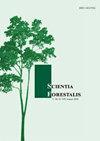Influência do revestimento nas propriedades de painéis compensados não-estruturais de uso exterior submetidos à câmara de intemperismo acelerado
IF 0.4
4区 农林科学
Q4 FORESTRY
引用次数: 0
Abstract
Plywood panels are widely used in civil construction as forms for concrete, being produced, for the most part, by veneers of Pinus spp. and adhesive based on phenol formaldehyde resin. However, after several reuses, the panels tend to lose their original strength and stiffness characteristics due to continuous exposure to weather, water from the concrete composition and sunlight. The objective of the study was to evaluate the influence of coatings on the technological properties of non-structural plywood for outdoor use of Pinus spp., after exposure to adverse conditions of radiation, precipitation and condensation in an accelerated aging chamber. Twenty 18 mm thick commercial panels were used, divided into 5 groups according to the surface: (i) uncoated (control), (ii) oil, (iii) melamine resin, (iv) melamine film and, (v) tego film. From each group, 80 specimens were removed, of which each subgroup of 20 was subjected to 0, 10, 30 and 50 cycles of radiation, precipitation and condensation in an accelerated aging chamber, according to the procedures described in ASTM G154 (2006). After completion of the cycles, the determination of density, moisture content, strength and stiffness to static bending, and strength in bonding line shear was performed. Data were evaluated in a multifactorial way in parametric statistics through analysis of variance and Tukey's test at 95% probability of success, considering 5 factors (coatings) and four levels (0, 10, 30 and 50 cycles). The results demonstrated thar the panels of all treatments met the parameters recommended by the Brazilian Association of Mechanically Processed Wood (ABIMCI) up to 50 cycles, that is, the coatings applied and the exposure time to radiation, precipitation and condensation variables did not adversely affect the panels in terms of strength and stiffness.涂层对加速风化室内室外非结构胶合板性能的影响
胶合板在民用建筑中被广泛用作混凝土的形式,大部分是由松木的贴面和基于酚醛树脂的粘合剂生产的。然而,经过多次重复使用,由于持续暴露在天气、混凝土成分中的水分和阳光下,面板往往会失去其原有的强度和刚度特性。本研究的目的是评估在加速老化室中暴露于辐射、降水和冷凝等不利条件后,涂料对室外用松木非结构胶合板技术性能的影响。使用了20块18mm厚的商业面板,根据表面分为5组:(i)未涂覆(对照),(ii)油,(iii)三聚氰胺树脂,(iv)三聚氰胺薄膜和(v) tego薄膜。根据ASTM G154(2006)中描述的程序,从每组中取出80个样品,其中每个亚组20个样品在加速老化室中进行0、10、30和50个辐射、沉淀和冷凝循环。循环完成后,进行了密度、含水率、静弯强度和刚度、粘接线剪切强度的测定。在参数统计中,通过方差分析和Tukey检验,以95%的成功率对数据进行多因素评估,考虑5个因素(涂层)和4个水平(0、10、30和50个周期)。结果表明,所有处理的面板都符合巴西机械加工木材协会(ABIMCI)推荐的参数,最多可达50次循环,也就是说,所使用的涂层和暴露于辐射,降水和冷凝变量的时间对面板的强度和刚度没有不利影响。
本文章由计算机程序翻译,如有差异,请以英文原文为准。
求助全文
约1分钟内获得全文
求助全文
来源期刊

Scientia Forestalis
Agricultural and Biological Sciences-Forestry
CiteScore
1.00
自引率
0.00%
发文量
39
期刊介绍:
Scientia Forestalis is a scientific publication of the IPEF – Institute of Forest Research and Studies, founded in 1968, as a nonprofit institution, in agreement with the LCF – Department of Forest Sciences of the ESALQ – Luiz de Queiroz College of Agriculture of the USP – São Paulo University. Scientia Forestalis, affiliated to the ABEC – Brazilian Association of Scientific Publishers, publishes four issues per year of original papers related to the several fields of the Forest Sciences.
The Editorial Board is composed by the Editor, the Scientific Editors (evaluating the manuscript), and the Associated Editors (helping on the decision of acceptation or not of the manuscript, analyzed by the Peer-Reviewers.
 求助内容:
求助内容: 应助结果提醒方式:
应助结果提醒方式:


